  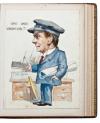 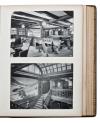 |
a silver-gilt and enamel mounted presentation album for the maiden voyage of the Hamburg-Amerika Line's S.S. Amerika, 1905
the first few pages with 14 mainly 6 x 8in. photographs showing the launch and some fitted interiors; nine watercolour caricatures of principal personnel aboard with captions, each monogrammed 'AD', four pages of German and English press cuttings; passenger list; concert party programme and manuscript menu from the 'Ritz Carlton', gilt-edged card pages bound within substantial blue calf boards with watered-silk lining, silver gilt corners hallmarked for London 1905-06, an enamelled House pennant, and banner title reading Souvenir of Maiden Voyage of / S.S. "AMERIKA" / Oct. 10th to Nov 5th, 1905 - 15 x 11¾in. (38 x 30cm.)
Provenance: Believed to have been owned by the Chief Steward.
Built for the Hamburg-Southampton-Cherbourg-New York service by Harland & Wolff Ltd and registered at 22,623 gross tons, Amerika was, for a year, the largest ship in the world until the Cunarder's Mauretania and Lusitania eclipsed her. In 1912 she collided with the British submarine B2 with the loss of 15 lives. Interned on the outbreak of War, she was seized by the US Government in 1917 and fitted as a troopship - a year later she collided with, and sank, the British cargo ship Instructor with the loss of 16. Post-War she was absorbed into the United States Lines with an Anglicized name and resumed passenger work. Laid up from 1931, she was re-converted to her troopship role in 1941 for the War. In 1951 she was laid up as a Government reserve ship before being broken up in 1958.
£1000-1500
|
|

|
R.M.S. QUEEN MARY: A COMMEMORATIVE ALBUM OF PHOTOGRAPHS BY STEWART BALE, LIVERPOOL, CIRCA 1937
comprising 57 9¼ x 11½in. black and white images showing construction, fitting, interiors and sailing views of the ship, each blind-stamped with the studio mark (lower right) and attached to card pages with manuscript captions contained within original green card album with studio complement slip and stamp inside covers; and loose image of the launching party, the album - 11½ x 15in. (29 x 38cm.)
Provenance: Presented to Sir John Stewart, Lord Provost of Glasgow, 23rd November, 1937, and thence by descent.
£1000-1500
|
|

|
PLATED TABLEWARE FROM THE TRANSATLANTIC STEAM SHIP COMPANY, CIRCA 1830
comprising a sugar bowl and milk jug, both engraved as per title, with maker's marks and crest underneath, sugar - 8in. (20cm.) wide
(2)
£200-300
|
|

|
R.M.S. CARPATHIA/TITANIC: A COMMEMORATIVE GOLD ANCHOR
in 18k gold, inscribed on the shank R.M.S. CARPATHIA / APR.15 1912, contained in original fitted plush-lined case with maker's marks for 'Jay's, London' - 1½in. (4cm.); 16.7g
£400-600
|
|
  |
A TITANIC MEMORIAL POSTCARD SIGNED BY SURVIVOR FREDERICK DENT RAY
the postcard circa 1912 published by Avenue Postcard Co., New York, signed in blue ballpoint pen by F.D. Ray, - 5½ x 3½in. (14 x 9cm.)
Provenance: given to the vendor by Mr Ray, circa 1965 as a birthday gift.
Frederick Dent Ray (1879-1977) was a 3rd Class Saloon Steward aboard Titanic. Completing his shift at 9pm on the 14th April, he retired to his room where he bunked with 27 others. When they were roused, he joined his lifeboat station (No.9) and saw it filled. He then assisted at the No.11 lifeboat, and then No.13 where, because of the few crew inside, he was told to get in. He saved the boat from two near-disasters on lowering (swamping and crushing) and gave evidence at the New York enquiry. He later became a poultry farmer in Sussex
£300-500
|
|
     |
STEAM YACHT BANSHEE R.Y.S
thirty six photographs of the interior and exterior of the Banshee, each with the blindstamp at foot of 'A. Debenham - Copyright - Cowes & Ryde' mounted on card pages, Original cloth. Oblong folio. London, 1901
A remarkably fine depiction of the steam yacht Banshee, with splendid exterior and interior views. Commissioned by millionaire Col. Harry MacCalmont to replace his Giralda which he ran between 1894-98, Banshee, built by Ramage & Ferguson in 1901, was a steel twin-screw schooner. Almost naval in appearance, she measured 229½ft, with a 29½ft beam and registered at 993 tons. After his untimely death in 1905, Banshee was sold to Portugal and became the R.Y. Amelia until the assassination of King Carlos in 1908. Thereafter she was used as a dispatch vessel in the Portuguese Navy and was dropped from Jane's list in 1937. MacCalmont built a third steam yacht, the nine-screwed Tarantula, which he owned concurrently with Banshee and which can be seen in the next lot.
£1000-1500
|
|
    |
'STEAM YACHTS'
thirty actual photographs mounted of steam yachts, with the inclusion of numerous press cuttings, illustrations, yachting celebrities and coloured illustrations of pennants and writing paper. Original cloth, slightly worn. Oblong folio, circa 1899-1900
Includes 'inter alia' Gerald; Rosabelle; Gunilda; Banshee; Queen Alexandra; Rozabelle; Venetia (three photographs) and Tarantula.
£500-800
|
|

|
'A CODE OF SIGNALS FOR THE USE OF VESSELS EMPLOYED IN THE MERCHANT SERVICE'
published with the permission of Capt. Marryat, published by J.M. Richardson, ninth edition 1844, hand-coloured plates on pull-out; together with private code for the Royal Victoria Yacht Club, original card boards with label for the Royal Victorian Yacht Club - 10 x 6½in. (25.5 x 16.5cm.)
Others: old yellowing and staining
Sold not subject to return
£400-600
|
|
| |
'The American Flag'
published by the New York Education Dept. 1910; together with Our Flags Their Original, Use, and Traditions by Rear Admiral S. Eardley-Wilmot, London 1901 - 9½ x 7½in. (24 x 19cm.)
(2)
£80-120
|
|
| |
Beken, Frank & Keith: 'The Beauty of Sail'
Illustrated. Original cloth, rubbed. - Guest, M. & W. Boulton, 'The Royal Yacht Squadron', portraits and plates. Original cloth, a little rubbed. And twenty other works.
(22)
This lot will be available for viewing at Imperial Road
£200-300
|
|
| |
TOUDOUZE, G.G. and others, 'Historie de la Marine'
numerous coloured and mounted plates and illustrations. Original decorated cloth. Paris, 1934. - Somer, Jack A. Athena. A Classic Schooner for Modern Times'. Two volumes. Original cloth, dust-jackets. And seven others.
(10)
This lot will be available for viewing at Imperial Road
£100-150
|
|
| |
Stephens, Owen J, Editor: 'J Class'
plates and illustrations. Vol I original cloth; vol II, original limp boards.
'Nautical Quarterly, Vols XXXI - XXXVII (lacks XXXII), illustrated in colour. Original pictorial cloth. And six other works.
(14)
This lot will be available for viewing at Imperial Road
£100-150
|
|

|
'British Yachts and Yachtsmen, A complete history of British Yachting'
mezzotint portrait of Edward VII, numerous plates and illustrations. London, The Yachtsman Publishing Company, 1907, - Heckstall-Smith, B. 'Yachts & Yachting in Contemporary Art'. Plates, some coloured and mounted. Original cloth. London, The Studio, 1925, limited edition. And six other works.
(8)
This lot will be available for viewing at Imperial Road
£200-300
|
|

|
CHARNOCK, JOHN: 'HISTORY OF MARINE ARCHITECTURE'
additional engraved title in vol I and 98 engraved plates (of 99). Some aquatint, a little foxing, original buckram. 4to London, various publishers, 1800-1801
(3)
£600-800
|
|

|
ALLEN, GRANT: 'THE TIDAL THAMES WITH ... PLATES BY W.L. WYLLIE A.R.A.'
five parts, 20 photogravure plates printed on India Paper, illustrations in the text. Folio, London, Cassell & Company, circa 1900. Original pictorial boards, contents loose. Printed for subscribers only
(5)
£400-600
|
|
  |
'FLAGS & FUNNELS OF THE BRITISH MERCANTILE MARINE'
published by The Journal of Commerce and Shipping Telegraph, Liverpool, circa 1918, printed sheet backed on linen and folded within card covers of issue - 22 x 32in. (56 x 81cm.) open; together with another, similar for circa 1920
(2)
£150-250
|
|

|
'COMPLETE BRITISH AND IRISH COASTING PILOTS, BEING A SET OF ACCURATE COASTING CHARTS, A NEW EDITION ARRANGED BY J. NORRIE'
25 (only 17 called for), double page or folding charts, one chart very large and folding, a few tears. Contemporary boards, broken. Folio, London, J.W. Norrie & Co., 1838
£1200-1800
|
|

|
'A CHART DESCRIBING PART OF THE COAST OF GREAT-BRITAIN, FROM THE SOUTH FORELAND TO BERWICK ...'
possibly after John Sennex, on laid paper with lightly shaded coastline naming principal towns - 21 x 23½in. (53 x 60cm.)
£100-150
|
|

|
A TECHNICAL WATERCOLOUR PROFILE FOR A MARINE MORTAR, CIRCA 1790
laid paper with side, top and front views delicately shaded in watercolour, a scale lower left and cartouche in German reading Der Block / Mit dem Beschlage / des / 24 Udigen / Mortiers / und / deßen Richtung - 12 x 18in. (30.5 x 46cm.)
£150-250
|
|
  |
A LARGE HELM FROM THE IRON BARQUE MARMION, BUILT BY JOHN REID & CO., GLASGOW, 1864
of typical construction with ten turned spokes with one capped in brass, inset brass securing plates around rim, wooden hub with brass plates and cap inscribed MARMION - 84in. (213.5cm.) diam
Built for Williams, Milligan of Liverpool, she plied a regular trade to Australia for just over 30 years before, in 1895, being sold to J. Boysen of Christiansand, Norway. She was finally broken up in Sweden in 1925 after 60 years of service
This lot will be available for viewing at Imperial Road
£800-1200
|
|

|
THE SHIP'S BELL FROM SWEDISH MERCHANT SHIP SOLIDEO GLORIA(1782)
cast in bell metal with foliate decoration and inscribed in the round SOLIDEO GLORIA ME FECIT ERIK LINDEMAN GEDANI / DE LONGE GOTTFRIED AN / LONGE CHRISTIAN: / ANNO 1782 (lacking section of crown top and clapper, overall wear) - 13in. (33cm.) high
Provenance: Swedish ships' bells appear to be unique in that they bear the name of the ship's owner as well as the maker of the bell, in this instance the ship's owner in Erik Lindeman and the maker is thought to be Christian
£600-800
|
|

|
A FINE AND LARGE CARVED TILLER, 19TH-CENTURY
with foliate rudderhead, barley-twist shaft, terminating in a Turk's head knot, hollowed underside and remnant gilt finish - 81in. (206cm.) long
£500-800
|
|
  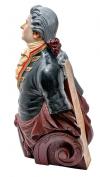 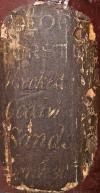 |
A FINE FIGUREHEAD RECOVERED DURING THE ATTEMPTED SALVAGE OF THE PRUSSIAN BRIG GEORGE FORSTER, WRECKED UPON THE GOODWIN SANDS, 30TH NOVEMBER, 1856
carved from solid elm with laminated arms as a half-length portrait depicting George Forster wearing a braided coat with finely carved jabot and hair, terminating in a scroll, faintly inscribed to front GEORGE / FORSTER / Wrecked on / Goodwin / Sands / March 30th 1830 [sic] - 50in. (127cm.) high
Provenance: Until recently this figurehead adorned the True Briton public house, Folkestone, where it had resided for an unknown period of time.
The Times for 1st December, 1856 reported the grounding of the Prussian ship George Forster the previous day, 30th November - one of six groundings between September and December that year. At the time it was stated that she was laden with timber and that steam tugs and lifeboats were standing by as it was "feared she would become a wreck". Both her main and mizzen masts had been cut away in an effort to re-float her at the next high tide and it seems highly likely that this figurehead - a weighty adornment when every ounce mattered - was removed at the same time in a last, desperate attempt to save the vessel. In the event it was all in vain as the ship broke her back and became a complete loss, although her crew was entirely saved.
George Forster (1754-94) was born near Danzig in what was then Polish Prussia to a family that had British antecedents. His father Johann, a reluctant cleric, took every opportunity to expand his travel and scientific knowledge and his enthused son soon followed suit. In 1766 the pair travelled to London in search for an appropriate position and, on their arrival, the elder Forster established contact with other German-speaking clergy and intellectuals in London. Among them was Carl Gottfried Woide, the Lutheran preacher and man of letters, who helped them find lodgings in Denmark Street and establish contacts within the British scientific and scholarly communities. In 1772 he was engaged to replace Joseph Banks as naturalist on James Cook's second Voyage of Discovery in the Resolution, and took young George along as his assistant. The voyage took the Forsters round the Cape of Good Hope to New Zealand, Tahiti, Tonga, and south beyond the Antarctic circle. George Forster's later reputation was based largely on the descriptions of the voyage he published after their return in 1775. The first of these was a botanical work, Characteres generum plantarum... MDCCLXXII-MDCCLXXV, published together with his father, which earned him election to the Fellowship of the Royal Society. A Voyage Round the World, in His Britannic Majesty's Sloop, Resolution (1777), which Forster published after his father had been denied the opportunity to write the official account of the voyage, had much greater impact. In 1779 he returned to Germany where he held several academic posts and from April to June 1790 he undertook a further journey, accompanied by Alexander von Humboldt. This time be travelled along the Rhine, through the Low Countries, and on to London, returning through revolutionary France and Forster's account of the journey was held in great esteem by contemporaries. Forster remained in Mainz after the occupation of the city by French revolutionary forces in 1792, becoming active in Jacobin circles. A supporter of the incorporation of the west bank of the Rhine into the French republic, in early 1793 Forster was elected deputy for Mainz to the national convention in Paris. His writings about the revolution were significant, if highly contentious, contributions to its reception in the German-speaking world. He died suddenly in Paris on 10th January, 1794 at the age of 39. It is not surprising that such a famous and significant character was honoured with the name of a ship by his fellow countrymen.
The George Forster figurehead in PerspectiveThe world of Ships Figureheads can be divided in to roughly four main subject forms: Female, Male, Creatures and Billets-types, each one having a number of subdivisions. Whilst it is no surprise that surviving female figureheads out number males by at least five to one, the vast majority of male figureheads are from unknown vessels, possibly depicting a forgotten vessel's owner or local dignitary; they represent the epitome of late Georgian and early Victorian gentlemen yet, occasionally, a male figurehead survives to show that exceptions to the rule can be found, and the George Forster is one such figurehead. His remarkable state of preservation, due in part to the fact that he has been carved from a solid block of elm, is an indication of high quality coupled with durability. Laminated yellow pine was used for the vast majority of figureheads at this date (around 1830) and was a lighter, less resilient wood, vulnerable to rot and splitting. The use of elm is significant in allowing the carved detail to be as crisp and sharp as the day he was carved. The carver would have relied on pictorial references supplied by the ship's owner, a number of contemporary portraits of both George and his father have survived, plus a number of illustrations published after his death, giving the carver ample reference material to create a portrait carving that has been painted almost to life. Great care and sensitivity has been taken with the face and hair and we see a handsome young man brimming with confidence that belies his tragic death, and particular attention has been made to the delicate and intricate folds of his jabot, while the base has a rich assortment of flowing material culminating in a very finely carved backwards scroll, with acanthus leaves - a true tour de force of the ship carvers skill
During the conservation work on George Forster the original colour scheme was researched and sensitively re-applied; it's not uncommon for a figurehead of this age to have numerous layers of inapt over-painting by the ship's crew and amateur artists, masking the true detail and appearance. In this instance, an important clue as to identity was found on the front of the figure, painted in gold leaf, in a style of typeface commonly used during the second quarter of the nineteenth century, in larger letters is "GEORGE FORSTER WRECKED ON GOODWIN SANDS" with a date of March 30th 1830. Subsequent research has shown this date to be incorrect and the true date of the wreck, while still on the Goodwin Sands, was in fact 1856 - an error put down to the sign writer. What is not disputed are the facts of the wrecking from the journal of the RNLI and The Times; or the exceptional quality of this carving with a strong provenance rarely seen today in today's market.
Richard Hunter
Figurehead Historian
£15000-20000
|
|
  |
A NOVELTY EDWARDIAN SMOKER'S COMPENDIUM
in the form of a yachtsman's cap, the crown opening to reveal cigar/cigarette tray, cigar cutter, ashtray and matchbox holder, maker's mark in lid for H. Rodrigues, 42 Piccadilly, London - 11in. (28cm.) wide
£300-500
|
|

|
A GONDOLA FORCOLA, VENICE, 20TH-CENTURY
in shaped wood of typical form, mounted on a square display base - 33½in. (85cm.) high
£500-800
|
|

|
two pairs of lignum vitÆ speaking tube terminals, 19th-century
turned with threaded connectors and removable whistles, one with ivory indicatator, each approximately - 3in. (7.5cm.) high
(4, two pairs)
£400-600
|
|

|
A FINE CASED SET OF TRANSATLANTIC TELEGRAPH CABLE SAMPLES BY SIEMENS, HALSKE & CO., LONDON, CIRCA 1868
twenty-four labelled specimens comprising eight cables in profile with engraved collars and additional cross-sections, terminus samples, insulation samples etc., in fitted plush-lined glazed Morocco leather case with maker's label for 'John Cowell & Co., Dublin' over lock and manuscript note inside reading Packenham Hall - the seat of the Earl of Longford - 12½in. (32cm.) square
£600-800
|
|

|
A RARE ROCKING AUTOMATON COLLECTION BOX FOR THE SHIPWRECKED MARINERS' SOCIETY, CIRCA 1900
the painted tin interior with rigged wooden barque pinned between 'waves' with collecting drawer under, glazed door with legend along lower edge, contained within oak box with coin slot to top, overall measurements - 16¾ x 12 x 7in. (42.5 x 30.5 x 17.5cm.)
£400-600
|
|
  |
A WALKING STICK CARVED FROM TIMBER RECOVERED FROM THE WRECK OF THE ROYAL CHARTER [1859]
of tapering form carved with foliate devices, silver cuff hand-inscribed ROYAL CHARTER / OCT 26 1859 / WRECKED - 34in. (86.5cm.) long
The auxiliary sailing ship Royal Charter was one of the most successful early steam vessels running to Australia during the decade following the gold rush, which began in 1851. After numerous highly profitable voyages, she left Melbourne on 26th August, 1859, homeward bound and carrying 388 passengers, 112 crew and a large cargo of bullion fresh from the goldfields. Quite apart from almost 70,000 ounces of gold valued at £273,000 and £48,000 in newly minted sovereigns, she was also carrying the personal wealth of a number of passengers who had made fortunes at the diggings
Arriving at Queenstown on 24th October after a record run of only 55 days, a large number of letters were dispatched announcing their safe arrival. As she sped up the Irish Sea, Captain Taylor ran inshore a little to allow his passengers a sight of Brunel's new monster steamship Great Eastern which was lying at Holyhead after her trials. Shortly after this minor detour, the wind started to freshen considerably. Taylor's signal rocket for a pilot at around 6.30pm. remained unanswered due to the weather and by 8.00pm. it was blowing a full gale. In an effort to gain a little more searoom, he ordered a few sails to be set but to no avail. The sheer power of the sea and the wind, which by now had veered around and was hurricane strength, was blowing Royal Charter towards the shore and her puny engine could do little to stop the drift. At 1.30am. the following morning the port anchor snapped and the starboard chain went an hour later. Swung around by the straining cable before it broke, Royal Charter was now bows on to the land and heading inshore. She grounded at about 3.30am. although little could be done to evacuate the ship until daylight. Valiant efforts to get a line for a bo'sun's chair ashore eventually succeeded, but hardly had a handful of men got off the wreck than a huge wave broke the ship in two at 7.00am. With practically all the passengers in the rear saloon, their fate was sealed; Only 40 persons survived the disaster and all were men - 22 passengers and 18 crew. Every woman and child (and Captain Taylor with all his officers) perished in the violence of the storm and those bodies which were recovered revealed the awful truth; very few had drowned, most had been battered to death on the rocky shore within feet of safety. The storm - one of the greatest of the 19th-century - became known to history as the "Royal Charter Gale".
£500-700
|
|

|
A YACHTING CLOCK RETAILED BY RAMAGE, LONDON, CIRCA 1920
the 4in. silvered dial signed under 'VI' Ramage, 68 Jermyn St, SW1, slow/fast lever above 'XII', French 8-day going barrel movement, glazed port, mounted in a wood and metal 'helm' for bulkhead suspension - 12½in. (32cm.) diameter
£150-250
|
|
 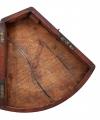 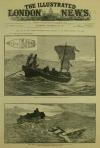   |
CAPTAIN DUDLEY'S SEXTANT FROM THE ILL-FATED YACHT MIGNONETTE, CIRCA 1875/1883
unsigned, the 7½in. radius brass 'A' frame vernier sextant with silvered scale divided to 120º, arc numbered '2258', vernier with tangent-screw adjustment and swivel magnifier, telescope arbor, mirrors, seven shades, wooden handle and pin feet, contained in original keystone box, the lid inscribed internally in pencil:
Lat. Long
Tuesday 2 4/57 1 1/20
Wednesday 2 4/50 1 1/50
Thursday 2 4/33 1 2/40
Friday 2 4/10 --
Saturday 2 4/02 15º-
Sunday 2 3/57 1 6/50
Monday 2 3/54 1 8/10
Tuesday 2 3/52 1 9/10
Wednesday 2 3/38 2 0/00
To whoever picks this up / Sunday July 20th PM / We Thomas Dudley, Edwin Stevens, / Edmund Brookes & Richard Parker, / the crew of the Yacht Mignonette which / foundered on Saturday the 5th. of July, have / been in our little dinghy 15 days. We have / neither food or water and are greatly reduced / We suppose our Latitude to be 25º South our Longditude / 28ºW May the Lord have mercy upon us / please forward this to Southampton
Overall measurements - 10 x 11in. (25.5 x 28cm.); together with a copy of 'The Custom of the Sea' by Neil Hanson in which the full account of the Mignonette and her crew is given.
(2)
Provenance: Moghul Antiques, Adelaide, South Australia (acquired from a deceased estate in Sydney); purchased by vendor from Moghul Antiques,1973.
The loss of the cutter yacht Mignonette and the subsequent fate of her crew must rival any of the greatest tales of woe upon the ocean and divided a shocked Victorian public when the full, gruesome details became public knowledge in the ensuing inquest.
The Mignonette was a 20 ton cruising yacht built in 1867 and at only 52 feet long, was designed for inshore sailing rather than any longer, more challenging voyages. She was bought in 1883 by John Want, an Australian lawyer who arranged, after some difficulty, with Tom Dudley (the captain) and three crew - Edwin Stephens; Edmund Brooks; and Richard Parker, the cabin boy, to take on the 15,000 mile voyage from Southampton to Sydney, Australia. Parker was 17 years old and an inexperienced seaman. Departing on 5th May, all was well until two months later on 5th July whilst heaving to about 1,600 miles off the Cape of Good Hope, a rogue wave smashed away a bulkhead and the yacht sank within five minutes
Scrambling into the flimsy open dingy, whose ¼in. planks were holed in the haste to depart, the shocked crew only had time to grab this sextant, a chronometer, and two tins of turnips - no water. On 9th July a turtle was spotted and sustained them for several days, but by 17th July the possibility of drawing straws to be sacrificed was being discussed. It seems that the condition of Richard Parker, the young cabin boy, was such that his fate was sealed and, on or near to the 24th July, Edwin Stevens cut his jugular vein so they could drink his blood, killing him. Feeding off his body for the next few days, on 29th July a sail was spotted and the German barque Montezuma rescued them and secured the dinghy. Delivering the survivors to Falmouth on the 6th September, candid statements were given to the authorities in the mistaken belief that they were protected by a "Custom of the Sea". As no such custom had been created in law, these statements formed the basis of the evidence against them in a trial that began on 3rd November. Public opinion swung firmly behind the unfortunate seamen, however a young and ambitious barrister called William Danckwerts was determined to make use of his previous success in wreck law and pursue a conviction of Murder on the High Seas. In effect, this became Britain's last trial for Cannibalism at sea. In the event, Brooks was acquitted, but Dudley and Stephens were found guilty and sentenced to death. The public outcry was such however that this was commuted to six months imprisonment. After the trial was over, John Want offered Dudley a new start in Australia and he opened a chandlery in Sydney, presumably taking this sextant with him.
£1000-1500
| Instruments | |
|
| |
A RUN OF CHRISTIE'S SCIENTIFIC INSTRUMENT CATALOGUES
comprising approximately 100 catalogues spanning 1969-2012
(100)
This lot will be available for viewing at Imperial Road
£300-400
|
|
| |
A RUN OF SOTHEBY'S SCIENTIFIC CATALOGUES
comprising approximately 160 catalogues spanning 1969-2003
(160)
This lot will be available for viewing at Imperial Road
£450-550
|
|
| |
SCIENTIFIC CATALOGUES
approximately 80 catalogues spanning 1973-2013 for auctioneers and dealers comprising: Bonhams, London; Phillips, London; Hervé Chayette, Paris; Trevor Phillips, London; Harriet Wynter, London; Jean Louis Picard, Paris; Tesseract, US
(80)
This lot will be available for viewing at Imperial Road
£100-150
|
|
| |
HARRIET WYNTER LTD CATALOGUES
bound in three volumes and comprising: Book Catalogues Vol 1 No. 4 March 1975-Winter 1977; Book Catalogues Vol 2 1978-1981; Instrument Catalogues Vol 1 No.1 to Vol 3 No.5 spanning January 1973-January 1977; together with some loose instrument catalogues from January 1977 and 1986.
(a lot)
£100-150
|
|
  |
A 3IN. POCKET GLOBE ATTRIBUTED TO DUDLEY ADAMS, LONDON, CIRCA 1800
twelve hand-painted gores with cartouche engraved A correct GLOBE with the new Discoveries, equatorial and solar eclipses, tracks for Cook, North America described as with Parts Unknown, Australia described as New Holland Nuyts Ld, delicately shaded country divides contained within a shagreen case with celestial gores lining, hand-coloured with cartouche inscribed A Correct Globe with new observations of Dr Halley & c. - 3in. (7.5cm.) diam
£2000-3000
|
|
  |
An early 19th-century French terrestrial table globe
signed in the main cartouche GLOBE TERRESTRE Dresse d'apres les relations les plus recents, par Th. Delamarche Successeur de Robert de Vaugondy 1821 and in a second cartouche À PARIS, Chez Fx Delamarche et Charles Dien, Rue du Jardinet No 13, Quartier St Andre des armes, showing the known geographical details of the time, such as central Africa marked Interieur tout-a-fait inconnu, no Lake Victoria, Hottentots to the South: Alaska as Amerique Russe, and the Amazon basin Territoire des Missions, the globe held in a horizon ring supported by four quadrants, in a turned ebonised wood column and circular base, glove - 8.5in. (22cm.) diam; overall stand - 19¾in. (50cm.) high
£2000-3000
|
|

|
An early 19th-century terrestrial table globe
signed in the cartouche GLOBE TERRESTRE Dresse d'apres les decouvertes Cook, Laperouse et d'autres voyageurs...C.F. Delamarche 1816, the known geography at the time as expected; North America as Amerique Septentrionale, with the Arctic coastline of (present-day) Canada not marked, River Nile no further than the Mountains of the Moon, Australia as Nouvelle Hollande, globe held in a horizon ring supported by four quadrants, on a turned ebonised wood column and circular base, globe - 8in. (22cm.) diam, overall height in stand 18¾in. (48cm)
£2500-3500
|
|

|
A mid-19th-century French terrestrial globe
signed and dated in the cartouche GLOBE adopte par le conseil de l'universite, Maison Delamarche, Rue Serpente No 25, Paris 1856, the River Nile peters out at the Montagnes de la Lune without showing Lake Victoria, Alaska as Amerique Russe, Tokyo Japan, Tokyo as Jedo, circumnavigational track of the French navigator D'Urville around the world traced (1837-1840), mounted in a horizon ring supported by four quadrants on a classical turned ebonised wood base, globe - 9in. (23cm.), overall in stand - 21½in. (54.5cm.)
£2500-3500
|
|
  |
A 9IN. TERRESTRIAL GLOBE PUBLISHED BY E. BERTAUX, PARIS, CIRCA 1890
comprising 12 coloured gores, the equatorial graduated in degrees, hours and minutes, the meridian of Paris graduated in degrees, the ecliptic graduated in days of the month and of the houses of the Zodiac, the Antarctic with little detail beyond Enderby's Land and Wilke's Land, the stamped brass hour dial, with engraved brass meridian half-circle, mounted on a tapered wooden column and plinth base - 19½in. (49.5cm.) high
£600-800
|
|

|
A 12IN. TERRESTRIAL GLOBE published BY DELAMARCHE, PARIS, CIRCA 1870
with chromolithographic gores signed DELAMARCHE / E. BERTAUX EDITEUR / 25 RUE SUR PENTE / PARIS / , meridian for Paris, tracks for Astrolabe 1826/27, d'Urville 1838 and 1840, Australia named Nouvelle Hollande ou Australie, graduated equatorial, with ecliptic line, mounted on a graduated brass meridian and supported on ebonised tapered base, overall height - 23½in. (60cm.)
£800-1200
|
|
 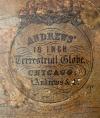 |
A 18IN. TERRESTRIAL LIBRARY GLOBE BY ANDREWS, CHICAGO, CIRCA 1890
comprising two sets of 12 chromolithographic half-gores, signed in cartouche Andrews' / 11inch / terrestrial globe / [A.H.] Andrews & Co mounted within a carved wooden stand with stretcher compass - 45in. (114cm.) high
£3000-4000
|
|
  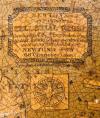 |
A good pair of mid-19th-century 9in table globes by Newton & Son, Chancery Lane, London,
terrestrial and celestial. According to the geography, the Earth globe can be dated after 1857 (showing Lake Victoria) but before 1865, when the United States covered the whole of that Country. The Celestial globe signed in the cartouche "Newton's Improved Celestial Globe.....66 Chancery Lane". The constellations shown include the original 48 proposed by Claudius Ptolomey plus, in the southern hemisphere, the later ones found and introduced 18th century, such as Telescopium, the Artist's Easel, the Pendulum Clock and the Octant. Globes mounted in a brass half circle, divided by degrees from zero to 90 and numbered every ten degrees. Turned mahogany pillar support with circular base. Overall height of globes in stands 37cm.
NB. Newton & Son, globe makers, are recorded as working at 66 Chancery Lane between 1841 and 1883. See Clifton, Gloria, Directory of British Scientific Instrument Makers 1550-1851.
£3000-5000
|
|
 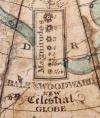 |
A 6IN. CELESTIAL BY BALE & WOODWARD, LONDON, CIRCA 1850
with hand-painted gores signed as per title above Orion, and mounted with calibrated brass meridian on wooden triform base - 11in (29cm.) high
£600-800
|
|
 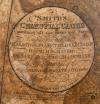 |
AN 18IN. CELESTIAL GLOBE BY SMITH & SON, LONDON, CIRCA 1830
the plaster core covered with twelve hand-painted gores, signed in the cartouche
Smith's Celestial Globe... Smith & Son 172 Strand, mounted on four-legged turned wooden table stand with graduated brass meridian ring and horizon ring (6 x 5in. damaged area by Taurus, meridian ring cracked) - 24 x 24in. (61 x 61cm.)
£2000-4000
|
|
  |
A 12IN. RELIEF GLOBE PUBLISHED BY THURY & BELNET, FRENCH, CIRCA 1860
signed as per title with medal accreditation for 1855 and 1858, comprising two sets of 12 chromolithographed raised gores with two polar calottes, with hour dial at the North Pole graduated meridian and horizon rings, mounted on a decorative cast-iron support on a marble plinth, overall measurement - 24in. (61cm.) high
£1000-1500
|
|

|
AN IRON METEORITE FROM THE SIKHOTE-ALIN IMPACT, RUSSIA, 12th FEBRUARY, 1947
formed as molten mass with a pitted surface, dark sheen and coppered patches, approximately - 2in. (5cm.) wide; 122.8g., contained in a glass display dome with legend; together with a small glass tektite sample from Lednice
(2)
According to eyewitness accounts, the meteorite that became known as the Sikhote-Alin Meteorite left a fireball trail some 20 miles long and was brighter than the sun. It was thought to have entered the Earth's atmosphere at 30,000 miles per hour and exploded into five or six large pieces when approximately 3½ miles high, with many smaller fragments such as this one falling over a square kilometre. Tektites are glass pebbles of unknown origin and found in various parts of the world, but are probably formed by meteorite impact. This one is from Lednice in the Czech Republic.
£200-400
|
|

|
A RECORDING AND INDICATING BAROGRAPH BY WEIR & SONS, BELFAST & DUBLIN, CIRCA 1910
the drum with 8-day clockwork motor, eight atmosphere pressure drum with reciprocal dial weather indicator signed along lower edge as per title, bevelled glass cover on display base with twin compartment chart drawer under - 8¼ x 14½in. (21 x 36cm.)
£250-350
|
|

|
A SMALL FRENCH GILT-BRONZE BAROGRAPH, CIRCA 1880
stamped and numbered on the bedplate 'PHNB 414', seven atmosphere drum acting on lacquered brass movement with clockwork barrel within bevelled glass gilt cover - 6¼ x 8½ x 5¼in. (16 x 21.5 x 13.5cm.)
£400-600
|
|

|
A BOW-FRONTED DOMESTIC BAROMETER BY DOLLOND, LONDON, CIRCA 1800
signed on the silvered scale as per title, the scale with vernier indicator and thermometer to left, ivory adjusting knob, ebonised reservoir cover and scroll pediment with urn finial - 40in. (101.5cm.) high
£600-800
|
|

